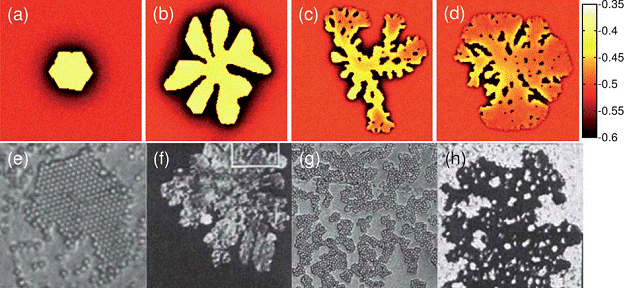
György Tegze1, László Gránásy1,2, Gyula Tóth3, Jack F. Douglas4, Tamás Pusztai1
1Institute for Solid State Physics and Optics, Wigner Research Centre for Physics, P.O. Box 49, Budapest H-1525, Hungary
2BCAST, Brunel University, Uxbridge, Middlesex, UB8 3PH, United Kingdom
3Department of Mathematical Sciences, Loughborough University, Loughborough, Leicestershire, LE11 3TU, U.K.
4Polymers Division, National Institute of Standards and Technology,Gaithersburg, MD, 20899, USA
The present work explores the ubiquitous morphological changes in crystallizing systems with increasing thermodynamic driving force based on a novel dynamic density functional theory. A colloidal 'soft' material is chosen as a model system for our investigation since there are careful colloidal crystallization observations at a particle scale resolution for comparison, which allows for a direct verification of our simulation predictions. We particularly focus on a theoretically unanticipated, and generic, morphological transition leading to progressively irregular-shaped single crystals in both colloidal and polymeric materials with an increasing thermodynamic driving force. Our simulation method significantly extends previous 'phase field' simulations by incorporating a minimal description of the 'atomic' structure of the material, while allowing simultaneously for a description of large scale crystal growth. We discover a 'fast' mode of crystal growth at high driving force, suggested before in experimental colloidal crystallization studies, and find that the coupling of this crystal mode to the well-understood 'diffusive' or 'slow' crystal growth mode (giving rise to symmetric crystal growth mode and dendritic crystallization as in snowflakes by the Mullins-Sekerka instability) can greatly affect the crystal morphology at high thermodynamic driving force. In particular, an understanding of this interplay between these fast and slow crystal growth modes allows us to describe basic crystallization morphologies seen in both colloidal suspensions with increasing particle concentration and crystallizing polymer films with decreasing temperature: compact symmetric crystals, dendritic crystals, fractal-like structures, and then a return to compact symmetric single crystal growth again.


